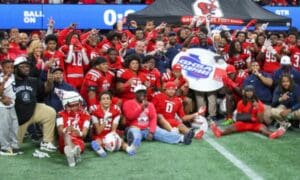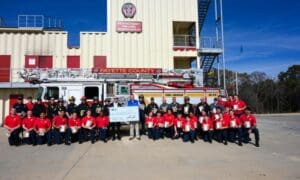Fayette Middle School (FMS) was one of four schools closed by the Fayette County Board of Education at the end of June. But the school today is being used for three school system programs and other uses. For the time being, based on information provided by the school system, there does not appear to be any additional expense by having FMS operational.
FMS closed at the end of June as part of the closure of four schools in the school system. The closures were associated with cost-saving measures that were accompanied by falling revenues, the potential for deficit spending and Fayette’s loss of approximately 2,000 students in the past few years.
During a school board meeting last summer, after the closures were implemented, it was announced that FMS would be utilized for three school system programs that had been being conducted at the Lafayette Education Center (LEC) and the former Rivers Elementary School. The announcement was made by school system administrative staff, with some on the school board questioning the decision and noting that the idea of using a school they voted to close had not come up at previous meetings. Though it’s no longer a middle school, FMS is currently open for business.
As noted in the school closure meetings last winter and spring, the closure of a school was expected to save $800,000 or more. The savings would come mainly in school administrative and other personnel costs, with a smaller amount coming from savings in utility costs. So what is the current use of FMS and what is the cost?
The programs currently in use at FMS include the Alternative School, Open Campus and Mainstay. The Alternative School and Open Campus had been housed at LEC while the Mainstay program serving some of the county’s special needs students was transferred a few years ago from its location at LEC to Rivers Elementary.
In terms of the number of students and staff populating the three programs today, that number has not changed. The Alternative school has 44 students and 12 staff, Open Campus has 110 students, six full-time staff and five part-time staff while Mainstay has 27 students and 12 staff. From the standpoint of money saved, the move to FMS is essentially neutral since those staff would be paid regardless their location, though there is one principal in charge at FMS.
As for why the programs moved to FMS, school officials said:
• The Alternative School was constantly disrupted because the “A” building at LEC is used for other functions. The media center room is used several times a month for large meetings and special events such as the science fair, recitation contests, math contests and large professional development meetings hosted by the curriculum department and various other central office departments.
• Building security — because other school system offices at LEC are located in both the “A” building and the “D” building, and particularly the “D” building, it would be impossible to keep the building from being open to anyone who needed or wanted to come in. The “D” building houses the “Bee Hive” teacher resource center, the community school office and the offices for the after-school program. Parents and the public frequently visit these offices. College classes are also taught in the “D” Building in the evening. This is not a situation conducive to maintaining a safe and orderly learning environment for the Open Campus.
• An additional use today at FMS includes an Advanced Placement Psychology class held in the FMS media center from 8-9 a.m. This class, with a current enrollment of 54, allows high school students from Starr’s Mill, Whitewater and Sandy Creek to have access to A.P. Psychology. The class is taught by one of the part-time Open Campus teachers. There is no space at the LEC that could accommodate this class on a daily basis.
The other expense expected to decrease with the school closures came from savings on utility costs. School system Facilities Director Mike Satterfield at a recent school board meeting said the average utility cost across the system equates to approximately $1 per square-foot of space.
Satterfield said FMS is heated and cooled by roof top units rather than a centralized plant.
“That placement affords the ability to divide the building into zones for heating and cooling. Open Campus is on the front hall, the Alternative School is in the middle hall and the Mainstay Program on the back hall. A combined class of high school students is using the media center in the mornings. The cafeteria and gym are also being used,” Satterfield said. “The entire school is being utilized for instructional purposes except for the band/chorus wing.”
Satterfield said FMS has a total of 135,649 square feet.
“Although we are utilizing almost the entire facility, it is for less hours per day and it is for a much smaller student body than the year before. The total utility cost for August, September, and October for 2012 were $72,708 while the total costs for 2013 were $26,859, a difference of $45,849. The weather for August, September, and October was extremely mild this year compare to 2012 which accounts for part of the savings,” Satterfield said.
At least for now, it appears that operating one of the school system’s four closed schools is not having a negative financial impact. What remains to be seen is what the utility costs will look like at the mid-year or full-year term compared to the utility costs at the other schools that were fully closed.












Leave a Comment
You must be logged in to post a comment.